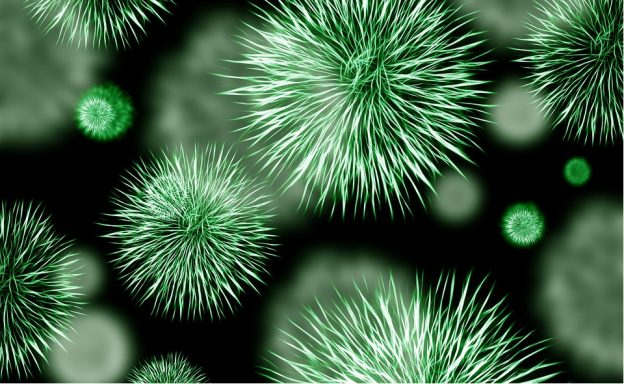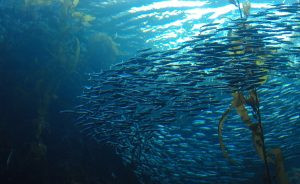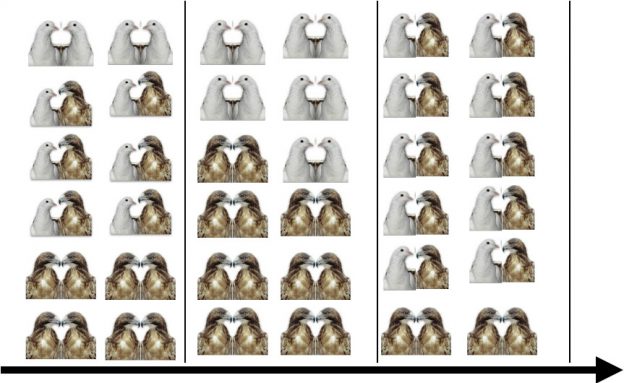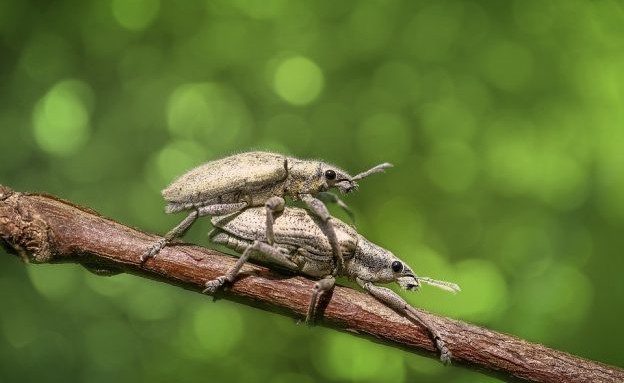In Krivan (2006) bacterial growth on a mixture of two sugars is modeled. It is well know that in mixed substrates with glucose and lactose bacteria often utilize glucose first and then switch to lactose (or to some alternate source of energy). At the molecular level this switch is known as the lac operon. In this article I ask: Is this switch evolutionarily optimized? In other words, do bacteria switch between the resources at the time that maximizes their fitness? To answer this question I build a model of bacterial growth on two substrates. The model assumes adaptive bacterial switching that maximizes bacterial per capita population growth rate – a proxy for bacterial fitness. Using some data from the literature, this model allows me to predict the time at which bacteria should switch. Then I compare this predicted time with observed times of switching for different substrates and different initial sugar concentrations. The observed times of switching show a very good agreement with predicted times. This strongly supports the idea that the molecular mechanism regulating resource switching is evolutionarily optimized. This is also a test of an optimal foraging theory when populations undergo population dynamics. On contrary to the majority of experiments on the optimal foraging theory that do not consider population dynamics of foragers, this model considers all populations dynamics.
Category Archives: Actual project
The Lotka-Volterra predator-prey game
The Lotka-Volterra predator-prey model is one of the earliest and, perhaps, the best known example used to explain why predators can indefinitely coexist with their prey. The population cycles resulting from this model are well known. In this article I show how adaptive behavior of prey and predators can destroy these cycles and stabilize population dynamics at an equilibrium. The classical predator-prey model assumes that interaction strength between prey and predators is fixed, which means that coefficients describing interactions between prey and predators do not change in time. However, there is increasing evidence that individuals adjust their activity levels in response to predation risk and availability of resources. For example, a high predation risk due to large predator numbers leads to prey behaviors that make them less vulnerable. They can either move to a refuge or become vigilant. However, such avoidance behaviors usually also decrease animal opportunities to forage which leads to foraging-predation risk trade-off. The present article shows that such a trade-off can have a strong bearing on population dynamics. In fact, while the classical Lotka-Volterra model has isoclines that are straight lines, the foraging-predation risk trade-off leads to prey (predator) isoclines with vertical (horizontal) segments. Rosenzweig and MacArthur in their seminal work on graphical stability analysis of predator-prey models showed that such isoclines have stabilizing effect on population dynamics because they limit maximum possible fluctuations in prey and predator populations. The present article shows that not only population fluctuations are limited, but they can even be completely eliminated.
Habitat selection game
The habitat selection game is a game theoretical concept that describes species distribution in22 heterogeneous environments. For a single population, Fretwell and Lucas (1970) defined the Ideal Free Distribution (IFD) in patchy environments, under which animal payoffs in all occupied patches are the same and maximal. Thus, the IFD is a Nash equilibrium of a game that we call the Habitat Selection Game. As any strategy that uses only already occupied patches will get the same fitness at the Nash Equilibrium, it is not clear if the Ideal Free Distribution is stable with respect to mutant invasions. Cressman and Krivan (2006) proved that the IFD is also an Evolutionarily Stable Strategy, i.e., resistant to mutant strategies. The habitat selection game was extended to two and multiple species. The IFD for two competing species in a two-patch environment was derived by Krivan and Sirot (2002). Cressman et al (2004) proved that this two-species IFD is also an Evolutionarily Stable Strategy for two populations. The effects of the IFD on population dynamics of two competing species was studied by Abrams et al. (2007). Evolutionarily stability under population dynamics were considered for multiple populations by Krivan and Cressman (2009) and for a single population by Cressman and Krivan (2010). Many results on habitat selection game for competing species or predator-prey interactions were reviewed in Krivan et al. (2008).

Consistency of host reproduction and infection transmission in sexually transmitted diseases
Classic models of infection dynamics describe host reproduction independently of infection transmission. This is fine for air-borne or vector-borne infections, and also for sexually transmitted diseases in humans, where only a negligible proportion of sexual intercourses results in reproduction. However, it can be an important omission in case of sexually transmitted diseases in many animals in which mating and reproduction are strongly correlated. Mating then mediates both host reproduction and infection transmission. Mathematical models of such infections should contain consistent description of both these processes, but this is rarely the case.
Probably the first model of this type of interaction was introduced in Berec & Maxin (2013). We showed that dynamics of the new model differed substantially from dynamics of a model traditionally used to describe this interation. Similar results were the obtained for another type of mating dynamics in Berec et al. (2017). The newly developed model in the latter work demonstrates a number of non-trivial bifurcations and complex behaviour with a number of alternative stable states. A model with consistency of host reproduction and infection transmission was also used in our effort to explain why just a few sexually transmitted pathogens increase mating changes of infected hosts (Berec & Maxin 2014) and to study willingness of the healthy individuals to mate with the infected ones (Theuer & Berec 2018).

Evolution of infection-induced host sterility
Harmful effects of parasitism include reduction of host reproductive abilities and increased host mortality. Whereas the former effect is commonly caused by sexually transmitted infections, increased mortality is typically due to other infection types. The initial models of the evolution of sterility virulence predicted development of fully sterilizing parasites, that is, infertility of the infected hosts. However, empirical observations agree with this prediction only partially. Therefore, the current effort is to reveal and understand mechanisms that prevent evolution of full sterilization and allow for evolution of only partial sterilization. This question I address also in my research. The actual study of this topic is the following one:

Evolution of Allee effects
Allee efekt nastává, klesá-li s klesající velikostí či hustotou populace zdatnost jedinců. S každým Allee efektem je tedy spojen určitý dědičný znak ovlivňující zdatnost a tedy podléhající přirozenému výběru. U Allee efektu, který vzniká díky klesající šanci nalézt si partnera při klesajících populačních hustotách, takovým znakem může být rychlost hledání partnera či doba, po kterou si může samice po pohlavním styku uchovat spermie.
Protože přítomnost Allee efektu snižuje zdatnost jedince, dalo by se očekávat, že se u těchto jedinců budou znaky vyvíjet tak, aby se zdatnost zvyšovala. Allee efekt by se tak měl zeslabovat nebo případně úplně vymizet. Může se zdát, že tomu tak je, neboť například adaptací pro snazší nalezení partnera pozorujeme mnoho, ať už jde o pohlavní či agregační feromony, ptačí zpěv, kvákání žab, schopnost se efektivně pohybovat, či schopnost proklamovat svou kvalitu skrze čestné signály. Na druhou stranu je Allee efekt, který vzniká díky klesající šanci nalézt si partnera při klesajících populačních hustotách, nejpozorovanějším typem Allee efektu. Musí tedy existovat nějaké evoluční tlaky, které “udržují Allee efekt při životě”.
Odpovědí zde mohou být časté kompromisy v životních strategiích, například pozorování, že rychlejší pohyb může vést ke snížení reprodukce či zvýšení mortality, jak ukazujeme v práci Berec et al. (2018a) a také v článku Berec et al. (2018b). Může ale také docházet k tomu, že znaky, které jsou výhodné při nízkých hustotách, nemusí být výhodné při hustotách vysokých. Při vysokých hustotách tak vlastně může docházet k zesílení Allee efektu, i když toto zesílení se navenek nijak moc neprojeví, neboť při vysokých hustotách jsou Allee efekty víceméně latentní. Projeví se však výrazně, dojde-li k relativně náhlému poklesu populační hustoty, například vlivem katastrofy či působení člověka. A zdá se, že tohle opravdu funguje, neboť velké množství pozorovaných silných Allee efektů nastává u populací redukovaných vlivem člověka, jak demonstrujeme v článku Gascoigne et al. (2009).

Evolutionary game theory with time constraints
Classic matrix models of evolutionary game theory assume that all interactions between strategies/phenotypes take the same amount of time. Here we are developing a new methodology to study models where interaction times depend on the two interacting strategies. We apply this theory to some classic evolutionary games. E.g., the classic Hawk-Dove game predicts that when interaction cost between two Hawks is low, the only evolutionarily stable strategy is all Hawks. In other words, when cost of aggressiveness is low, all individulas will be aggressive. However, when Hawk-Hawk interactions take long enough time, when compared with duration of other interactions, aggressiveness evolves even when the cost of fighting is low. For the repeated Prisoner’s dilemma, cooperation evolves if individuals opt out against defectors. This means that if a cooperator meets another cooperators, they will stay together as long as possible. However, if a cooperator meets a defector, it will play the game only once and then the pair will disband.

Mate-finding Allee effect
Allee efekt díky páření je nejpozorovanějším typem Allee efektu, jak se můžeme přesvědčit v tomto článku. Vzniká díky snížené schopnosti jedinců nalézt si partnera v populacích s nižší hustotou, což například v případě rostlin může znamenat, že pylovému zrnku se nepodaří dostat k samičím reprodukčním orgánům. V rámci našeho výzkumu se snažíme prostřednictvím matematických modelů zjistit, jak je síla tohoto Allee efektu určena různými prvky pářícího procesu, jako je například počet možných partnerů, rychlost hledání partnera či heterogenita populace. Zajímá nás také, jak lze tento Allee efekt efektivně využít při kontrole škůdců, ať už samostatně či s podporou jiných mechanismů vedoucích na Allee efekt. Aktuální práci na toto téma je možné najít v článku: